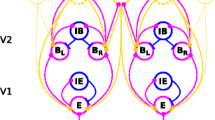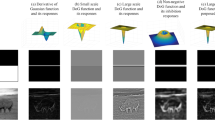Abstract
A new model for visual boundary detection and contour grouping is presented that is based on functional elements of resonant matching of activation between neural layers in cortical architecture. The model architecture relates to visual cortical areas V1 and V2 which are bidirectionally interconnected via feedforward as well as feedback projections. It is suggested that their functionality is primarily determined by the measurement and integration of signal features that are continuously matched against neural codes of expectancies generated by the long-range integration of coherent activity. The net effect produces grouping and illusory contour completion at model V2 as well as context-sensitive shaping of orientation tuning and selectivity of receptive fields at model V1 layer. A pilot implementation of the model architecture has been successfully tested on various test stimuli.
Preview
Unable to display preview. Download preview PDF.
Similar content being viewed by others
References
R. Eckhorn, H.J. Reitboeck, M. Arndt, and P. Dicke. Feature linking via synchronization among distributed assemblies: Simulations of results from cat visual cortex. Neural Computation, 2:293–307, 1990.
D.J. Field, A. Hayes, and R.F. Hess. Contour integration by the human visual system: Evidence for local ‘association field'. Vision Research, 33(2):173–193, 1993.
C.D. Gilbert and T.N. Wiesel. The influence of contextual stimuli on the orientation selectivity of cells in primary visual cortex of the cat. Vision Research, 30(11):1689–1701, 1990.
A. Gove, S. Grossberg, and E. Mingolla. Brightness perception, illusory contours and corticogeniculate feedback. Visual Neuroscience, 1995. (in press).
S. Grossberg. How does a brain build a cognitive code? Psychological Review, 87:1–51, 1980.
S. Grossberg and E. Mingolla. Neural dynamics of perceptual grouping: Textures, boundaries, and emergent segmentation. Perception and Psychophysics, 38(2):141–171, 1985.
F. Heitger and R. von der Heydt. A computational model of neural contour processing: Figure-ground segregation and illusory contours. In Proc. 4th Int. Conf. on Computer Vision, ICCV-93, Berlin, May 11–14 1993.
P.J. Kellman and T.F. Shipley. A theory of visual interpolation in object perception. Cognitive Psychology, 23(2):141–221, 1991.
J.J. Koenderink and A.J. van Doorn. Generic neighborhood operators. IEEE Transactions on Pattern Analysis and Machine Intelligence, PAMI-14(6):597–605, 1992.
D. Mumford. On the computational architecture of the neocortex II: The role of cortico-cortical loops. Biological Cybernetics, 65:241–251, 1991.
P. Parent and S.W. Zucker. Trace inference, curvature consistency, and curve detection. IEEE Transactions on Pattern Analysis and Machine Intelligence, PAMI-11(8):823–839, 1989.
W.D. Ross, S. Grossberg, and E. Mingolla. A neural model of illusory contour formation in V1 and V2. In Proc. ARVO'95 (Investigative Ophtalmology and Visual Science, PGM# 2187), 1995.
R. von der Heydt and E. Peterhans. Mechanisms of contour perception in monkey visual cortex. I. Lines of pattern discontinuity. The Journal of Neuroscience, 9(5):1731–1748, 1989.
S.W. Zucker, A. Dobbins, and L. Iverson. On the computational neurobiology of curve detection. In Proc. British Machine Vision Conference (BMVC90), pages xvii–xxiii, Oxford (GB), Sept. 24–27 1990.
S.W. Zucker, R.A. Hummel, and A. Rosenfeld. An application of relaxation labeling to line and curve enhancement. IEEE Transactions on Computers, C-26(4):394–403, 1977.
Author information
Authors and Affiliations
Editor information
Rights and permissions
Copyright information
© 1996 Springer-Verlag Berlin Heidelberg
About this paper
Cite this paper
Neumann, H., Mössner, P. (1996). Neural model of cortical dynamics in resonant boundary detection and grouping. In: von der Malsburg, C., von Seelen, W., Vorbrüggen, J.C., Sendhoff, B. (eds) Artificial Neural Networks — ICANN 96. ICANN 1996. Lecture Notes in Computer Science, vol 1112. Springer, Berlin, Heidelberg. https://doi.org/10.1007/3-540-61510-5_144
Download citation
DOI: https://doi.org/10.1007/3-540-61510-5_144
Published:
Publisher Name: Springer, Berlin, Heidelberg
Print ISBN: 978-3-540-61510-1
Online ISBN: 978-3-540-68684-2
eBook Packages: Springer Book Archive




